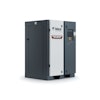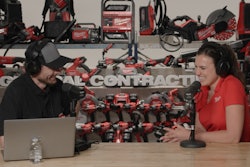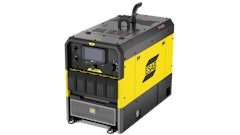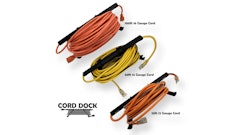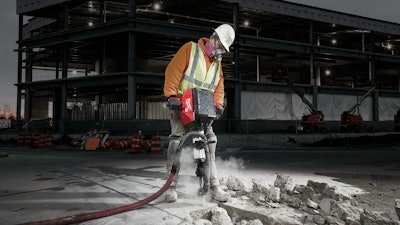
Productivity in the construction industry is a must-have and finding equipment that can deliver the power and performance required while maintaining cost is critical to optimize efficiency on the jobsite. Determining what equipment to invest in for the proper balance between power, performance and cost can be a daunting task. The right equipment can make a major difference when getting the job done. There is a lot to consider, especially as battery-powered equipment continues to make a rise in the industry.
Traditionally gas-powered engines have been the most powerful, but advances in both equipment design and battery technology allow for enhanced capabilities and more efficient power utilization. These advances mean there are more companies moving to cordless jobsites. Due to the technology in battery-powered solutions, manufacturers are able to adjust the RPMs on cordless equipment to fine-tune a product and eliminate the fluctuation of RPMs.
Often battery-powered equipment can be a larger upfront cost than its gas counterparts, however, the productivity of the day-to-day work and maintenance over the lifetime of the product can potentially save contractors both money and time. For example, if you average electricity rates by state and account for more densely populated states that cost more per kWh, on average Milwaukee Tool’s MX FUEL batteries cost about $0.13-0.15 to charge, significantly bringing down the cost to run equipment all day. (A 2X margin was added to account for the high-cost states.) Considering that the Milwaukee MX FUEL Battery Pack contains about 1/2 a kWh, it should cost about half the average to charge a full pack. Often battery-powered equipment can be a larger upfront cost than its gas counterparts, however the savings on both gas and maintenance over the lifetime of the product saves users both money and time.
 Milwaukee’s MX FUEL Handheld Core Drill with AUTOSTOP technology provides maximum control and reduced kickback during bind-up situations delivering a safer coring experience.Milwaukee Tool Corp.
Milwaukee’s MX FUEL Handheld Core Drill with AUTOSTOP technology provides maximum control and reduced kickback during bind-up situations delivering a safer coring experience.Milwaukee Tool Corp.
Equipment is a huge investment and proper maintenance to extend the product's lifetime is one of the most important ways to protect that investment. Gas-powered equipment requires routine maintenance in order to minimize repair costs and maximize profit. This can increase the cost of ownership over the lifetime of the product. Largely due to battery products not having wearable parts such as air filters, carburetors, spark plugs, or recoils, battery-powered equipment eliminates the need for maintenance caused by having a gas engine.
Exposure to emissions, trip hazards, vibration, and the noise continues to create health concerns for professionals in the construction trades. Building a company-wide safety culture to protect workers is a choice that is reinforced in daily decisions such as equipment selection and saws, breakers, and generators can be major offenders in safety hazards. As such, many jobsites are making the switch to battery-powered equipment for not only the power and performance but added safety benefits.
More on Battery-Powered Construction Equipment on ForConstructionPros.com
Milwaukee Tool's Brian Alves Talks About the New MX Fuel Equipment System - The MX Fuel Equipment System is the first ever system of battery-powered light equipment.
Snorkel's Take on the Future of Lithium-Powered Machines - In this episode of The Bottom Line, Rental Editor Alexis Sheprak talks with Matthew Elvin, CEO of Xtreme Manufacturing and Snorkel for the global manufacturing business.
Briggs & Stratton Unveils Lithium-Ion Battery Technology - Briggs & Stratton has developed a 5 kW lithium battery power source, and plans 2.5 kW and 10 kW options in the future.
Calling An Audible: Use Battery-Powered Equipment To Reduce Noise & Vibration - Today’s crews have a new mindset and expectations. They realize traditional risks, including from noise and vibrations, are addressable on a jobsite.
There are a few key equipment aspects to keep in mind when considering jobsite safety and weighing productivity.
Emissions. When gas-powered equipment is used in buildings or semi-enclosed spaces it puts users at risk of CO poisoning. Gas can rapidly accumulate, even in areas that appear to be well-ventilated, and build up to dangerous or fatal concentrations within minutes. Battery-powered equipment is completely emissions and fume free meaning users don’t have to interact with gas nearly as much.  Battery-powered equipment eliminates gas engines, thus eradicating the fumes that they create providing a much less hazardous environment. Not only will battery-powered light equipment like Milwaukee’s MX FUEL 14-in. Cut-Off Saw save on the time and money associated with maintaining gas engines, but it will also help keep workers safer in the long run.Milwaukee Tool Corp.
Battery-powered equipment eliminates gas engines, thus eradicating the fumes that they create providing a much less hazardous environment. Not only will battery-powered light equipment like Milwaukee’s MX FUEL 14-in. Cut-Off Saw save on the time and money associated with maintaining gas engines, but it will also help keep workers safer in the long run.Milwaukee Tool Corp.
Occupational Safety and Health Administration (OSHA) has strict regulations regarding the handling and storing gas on the jobsite. By going cordless contractors can eliminate the need to set up things such as gas cages, saving time and money. Additionally, it can eliminate regulatory safety protocols around gas storage and proper use in equipment saving the possibility of repair or replacement due to bad maintenance.
Safety Technology. The specialized engineering of a tool can physically reduce a worker’s risk of injury with little to no change in their workflow. Battery-powered equipment allows for the use of sensor technology inside the product providing safety technology that is designed and built to protect users whenever equipment is running, without added thought.
These safety technologies can aid in control and reduce kickback during bind-up situations delivering a safer experience. Tools featuring these solutions typically have engineered set points to automatically stop the equipment or tool when thresholds are reached for a specific amount of time. In a core drill, for example, an internal gyroscope monitors angular momentum and uses onboard sensors to remove power from the motor before it rotates more than 45 degrees. At that engineered limit, the equipment will no longer fight the user.
Anti-vibration. The electronic technology in battery-powered solutions reduces the vibration and therefore reduces the chance of these types of long-term safety concerns. The risk of harm from vibration, for which there is no OSHA standard, depends on intensity, frequency, and length of exposure. Vibrations can affect the entire body bringing symptoms like back pain or shakiness. This can be experienced after many day-to-day activities such as a long car or boat trip or after operating heavy equipment, including bulldozers and jackhammers. Due to extended exposure to vibration, skilled trade workers are known to suffer from localized Hand-Arm Vibration Syndrome (HAVS), when vibrations gradually cause permanent changes in tendons, muscles, bones, and joints. A well-known disorder from HAVS is “Vibration-Induced White Finger,” or “Raynaud’s disease,” which causes fingers and toes to feel numb and cold in response to temperatures or stress.  Milwaukee’s MX FUEL Backpack Concrete Vibrator cuts the noise, reduces the felt vibration, and adds no emissions to a contractor's CO2 footprint.Milwaukee Tool Corp.
Milwaukee’s MX FUEL Backpack Concrete Vibrator cuts the noise, reduces the felt vibration, and adds no emissions to a contractor's CO2 footprint.Milwaukee Tool Corp.
Anti-vibration technology can be found in the electronics and mechanics of a tool. However, mechanical anti-vibration technology in a breaker, for example, includes its spring design and floating head separating the head from the striking mechanism. This keeps the user further from the point of impact to cushion the impact. This reduction allows the user to experience less fatigue and reduced circulatory issues specifically around their hands.
Cordless. The second most reportable OSHA violation is slips, trips, and falls so battery-powered equipment eliminates that extra tripping hazard that people must navigate. If gas equipment was used, crews had to stop and prep a work area first to provide ventilation. Eliminating this can potentially add productivity and take away fuel and maintenance costs. Battery-powered equipment allows users to work both emissions-free and cord-free, ultimately giving users a new way to complete the application more seamlessly and efficiently.
Noise. Hearing damage can occur with long-term exposure to loud noises or the sudden blast potentially bursting an eardrum. Battery-powered equipment typically operates at lower decibels helping to prevent hearing damage or loss. The lower noise level also means users can communicate while they’re operating the tools, adding safety and productivity.
The mindset on today’s jobsites has changed. Workers realize that the historic safety risks they used to accept as “part of the job” are now addressable. Along with greater safety for workers, productivity is boosted by fewer days away from work due to injuries. Battery-powered equipment offers an effective alternative to gas engine noise and vibrations, providing a better experience and increased safety and productivity.
About the author
As Director of Product Management, Kevin Gee is responsible for overseeing the strategy and product development for Milwaukee Tool's MX FUEL Cordless Equipment System and Concrete solutions.




